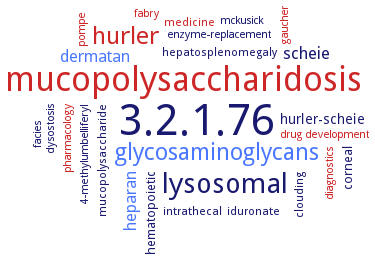3.2.1.76: L-iduronidase
This is an abbreviated version!
For detailed information about L-iduronidase, go to the full flat file.

Word Map on EC 3.2.1.76 
-
3.2.1.76
-
mucopolysaccharidosis
-
lysosomal
-
hurler
-
glycosaminoglycans
-
scheie
-
dermatan
-
heparan
-
hurler-scheie
-
hematopoietic
-
corneal
-
medicine
-
mucopolysaccharide
-
intrathecal
-
clouding
-
hepatosplenomegaly
-
iduronate
-
pompe
-
pharmacology
-
enzyme-replacement
-
4-methylumbelliferyl
-
facies
-
mckusick
-
diagnostics
-
dysostosis
-
fabry
-
drug development
-
gaucher
- 3.2.1.76
- mucopolysaccharidosis
- lysosomal
- hurler
- glycosaminoglycans
-
scheie
- dermatan
- heparan
-
hurler-scheie
-
hematopoietic
- corneal
- medicine
-
mucopolysaccharide
-
intrathecal
-
clouding
-
hepatosplenomegaly
-
iduronate
- pompe
- pharmacology
-
enzyme-replacement
-
4-methylumbelliferyl
-
facies
-
mckusick
- diagnostics
-
dysostosis
- fabry
- drug development
- gaucher
Reaction
Synonyms
Aldurazyme, alpha-IDUA, alpha-iduronidase, alpha-L-iduronidase, alpha-L-iduronidase A, glycosaminoglycan alpha-L-iduronohydrolase, hIDUA, IDU, IDUA, iduronidase, laronidase, More, rIDUA_RLT
ECTree
Advanced search results
General Information
General Information on EC 3.2.1.76 - L-iduronidase
Please wait a moment until all data is loaded. This message will disappear when all data is loaded.
evolution
malfunction
physiological function
-
the enzyme is involved in the degradation of the glycosaminoglycans dermatan sulfate and heparan sulfate
additional information
-
the enzyme uses its own N-glycan as a substrate binding and catalytic module. The mannose residue of the N-glycan attached to N372 constitutes a part of the substrate-binding pocket and interacts directly with a substrate. The kinetics of native and deglycosylated hIDUA suggest that the N-glycan is also involved in catalytic processes. Concanavalin A pull-down assay shows that PNGase F-resistant N-glycans are essential for the enzyme activity. Enzyme and substrate binding site structures and enzyme-substrate interaction analysis, overview
malfunction
-
mutations in the IDUA gene cause mucopolysaccharidosis type I, MPS I, a progressive multisystem disorder
malfunction
-
mutations in the IDUA gene cause mucopolysaccharidosis type I, MPS I, a progressive multisystem disorder with features ranging over a continuum from mild to severe which is inherited in an autosomal recessive manner
malfunction
-
mucopolysaccharidosis type I arises from a deficiency in the alpha-L-iduronidase enzyme
malfunction
-
mucopolysaccharidosis type I is caused by a deficiency in lysosomal alpha-L-iduronidase activity
malfunction
-
mucopolysaccharidosis type I is caused by a deficiency in lysosomal alpha-L-iduronidase activity
malfunction
-
deficiency of the enzyme leads to progressive accumulation of glycosaminoglycans, dermatan and heparan sulfate, in all organs and tissues, mucopolysccharidosis I is a lysosomal storage disorder that results from deficiency in the lysosomal enzyme alpha-L-iduronidase. Infusions of intravenous enzyme improves hepatosplenomegaly, pulmonary function, ambulation, jointmobility, cardiac function, and cognitive and neuroradiological progress
malfunction
enzyme deficiency causes mucopolysaccharidosis type I, patients with MPS I developmental retardation, gross facial features, an enlarged and deformed skull, a small stature, corneal opacities, hepatosplenomegaly, valvular heart defects, thick skin, joint contractures and hernias
malfunction
-
enzyme dysfunction causes accumulation of dermatan/heparan sulfate leading to mucopolysaccharidosis type I. The defect of the enzyme leads to excess storage of dermatan/heparan sulfate and causes a systemic disorder, MPS I, involving progressive mental retardation, gross facial features, an enlarged and deformed skull, a small stature, corneal opacities, hepatosplenomegaly, valvular heart defects, thick skin, joint contractures, and hernias
malfunction
-
mucopolysaccharidosis I is an autosomal recessive lysosomal storage disease due to deficient alpha-L-iduronidase activity. It results in the accumulation of the glycosaminoglycans heparan and dermatan sulfate and leads to several clinical manifestations
malfunction
-
mucopolysaccharidosis type I, MPS I, is an autosomal recessively inherited lysosomal storage disorder caused by the lack of alpha-L-iduronidase which leads to accumulation of glycosaminoglycans in the lysosome, genotyping of cell lines with residual enzyme activity, overview
malfunction
mucopolysaccharidosis type I is caused by the deficient activity of the enzyme


 results (
results ( results (
results ( top
top






